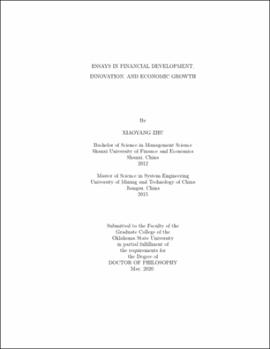| dc.contributor.advisor | Kim, Jaebeom | |
| dc.contributor.author | Zhu, Xiaoyang | |
| dc.date.accessioned | 2020-09-09T20:49:18Z | |
| dc.date.available | 2020-09-09T20:49:18Z | |
| dc.date.issued | 2020-05 | |
| dc.identifier.uri | https://hdl.handle.net/11244/325453 | |
| dc.description.abstract | My dissertation comprises two chapters. The first chapter uses country-level data and examines the diminishing effect of financial development on innovation, and how "too much finance" affects economic growth through this diminishing effect. The second chapter uses industry-level data aggregated from firm-level data to examine the nonlinear effect of financial development on innovation as well as explores the channels. | |
| dc.description.abstract | The first chapter explores the nonlinear effect of financial development on innovation and growth. We show that the expansion of the financial sector may hurt innovative activities and hence the innovation-led growth, using data on 50 countries over the 1990-2016 period. Countries with a higher level of financial development are found to have a smaller positive or insignificant effect on innovation. The marginal effect of innovation on growth is a decreasing function of financial development. Using a novel dynamic panel threshold method we examine the possible nonlinearity between finance, innovation, and growth. We find that innovation exhibits an in- significant effect on output growth when credit to the private sector exceeds the level of 60% as a share of GDP. These results are not driven by banking crises, the long-run effect of the 2007-2008 financial crisis, or the ongoing European sovereign debt crisis. | |
| dc.description.abstract | This second chapter studies the nonlinear effect of financial development on innovation as well as the potential channels, primarily using a unique database constructed from the Worldscope Fundamentals Annual from 1980 to 2017. Our results can be summarized as follows. 1) Using a broad index of financial development, we find that the overall effect on innovation is a diminishing one, and the patterns are robust under different robustness checks. 2) We also have documented that, using traditional one-dimension indicators of financial development for both equity and credit markets, equity markets have a kick-in effect on innovation, while the diminishing effects still hold for credit markets. 3) We find industry-specific effects. In particular, the equity market development has a diminishing effect on innovations in high-technology industries, while credit market development has a diminishing effect on innovations in non-high-technology industries. 4) We show that the nonlinear effect of financial development on market competition serves as a potential channel through which finance affects innovation nonlinearly. 5) Our last finding is that the effect is heterogeneous across different stages of development. | |
| dc.format | application/pdf | |
| dc.language | en_US | |
| dc.rights | Copyright is held by the author who has granted the Oklahoma State University Library the non-exclusive right to share this material in its institutional repository. Contact Digital Library Services at lib-dls@okstate.edu or 405-744-9161 for the permission policy on the use, reproduction or distribution of this material. | |
| dc.title | Essays in financial development, innovation, and economic growth | |
| dc.contributor.committeeMember | Shen, Wenyi | |
| dc.contributor.committeeMember | Adkins, Lee | |
| dc.contributor.committeeMember | Carter, David | |
| osu.filename | Zhu_okstate_0664D_16668.pdf | |
| osu.accesstype | Open Access | |
| dc.type.genre | Dissertation | |
| dc.type.material | Text | |
| dc.subject.keywords | economic growth | |
| dc.subject.keywords | financial development | |
| dc.subject.keywords | innovation | |
| dc.subject.keywords | market structure | |
| dc.subject.keywords | nonlinear effect | |
| thesis.degree.discipline | Economics | |
| thesis.degree.grantor | Oklahoma State University | |
